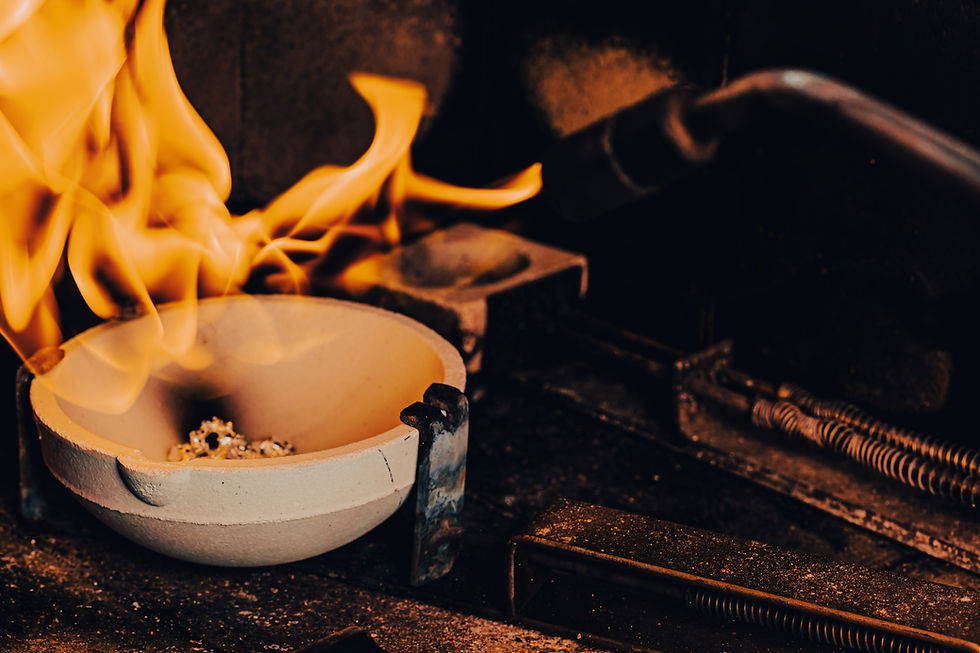Making Sapphire & other Precious Gemstones
- Sylvia Rose

- Sep 23, 2024
- 4 min read
Updated: Sep 23, 2024
Synthetic sapphires and lab-grown gemstones mimic the brilliance and allure of natural gems while often surpassing them in quality and clarity. Beauty and hardness of sapphires are renowned throughout history. Here are the main synthetic processes.

Synthetic gemstones are created to replicate the chemical, physical, and optical properties of natural gemstones. Unlike imitation stones, which look similar to real gems without sharing their composition, synthetic stones are about the same as their natural counterparts.
Market-driven demand for sapphires has surpassed available natural resources. Gem-quality corundum, comprising sapphires and rubies, is even scarcer than diamonds. Sapphires and rubies are among the earliest gemstones to be artificially produced over a century ago.

Today, manufacturers use many of the same technological processes from that era to synthesize sapphires. In ancient alchemy, dyeing of quartz to resemble gemstones like emerald, ruby and amethyst is a skill of alchemy.
Did alchemists create synthetic gemstones as they did silver and gold? Real gems are created in the Earth over millions of years by heat and pressure. This process can be replicated in a few ways.

Synthetic gemstone production in laboratories attempts to replicate the natural formation of gemstones under controlled conditions. The most inexpensive and oldest melt process is flame fusion or the Verneuil process.
1. The Verneuil Process
Developed in the late 19th century, the Verneuil process is one of the oldest and most widely used methods for producing synthetic sapphires and rubies. This flame-fusion technique involves melting aluminum oxide powder in a high-temperature flame. The powder melts at 2,072 °C (3,762 °F; 2,345 K).

In this method, a flame melts aluminum(III) oxide powder. Aluminum(III) oxide or aluminum oxide is the main component of corundum. The melted drops form into a long teardrop shape called a "boule" with characteristics of a corundum.
Aluminum oxide comes from the mineral bauxite, the primary source of aluminum. Aluminum salts are widely used in ancient and medieval alchemy.

As the molten material cools, it crystallizes into a solid form. The Verneuil process is relatively quick and allows for the production of large, flawless gems. However, the crystals often exhibit a characteristic "flame" structure, which can be a telltale sign of their synthetic origins.
Synthetic sapphires are created in a lab with specialized machinery. To tell synthetic from earth-grown, look for flaws and inclusions in sapphires and ruby. Natural corundum often has inclusions, giving an inner glow, and some synthetic stones have air bubbles.

Physically aluminum(III) oxide is the chemical composition of corundum. Like the earth-made germs, synthetic sapphires possess remarkable hardness and durability.
Natural corundum comes in a 9 on the Mohs hardness scale. Although hard, the stones, like diamonds, are brittle. Thus, a good hammer blow will destroy a real gem, including sapphire, ruby and emerald (a type of beryl) as easily as glass.

2. The Czochralski Process
The Czochralski process, or crystal pulling method, is another popular technique used for creating synthetic gemstones. In this method, high-purity materials are melted in a crucible, and a seed crystal is dipped into the melt.
The maker inserts a rod tipped with seed crystal into the mixture, slowly rotates it and pull it out, creating a column of sapphire. This can create up to 4" of crystal per hour. Slowly pulling the seed upwards causes the material to solidify and form a large crystal.
This method is particularly suited for producing larger and more perfect crystals than the Verneuil process.

3. Hydrothermal Synthesis
The process involves placing a small amount of natural mineral, a seed crystal, into a solution of minerals and water at high pressure and temperature. Over time, this environment allows the minerals to crystallize and form synthetic gems.
Hydrothermal synthesis is used to create a variety of gemstones, including emeralds and sapphires. It's desirable for the quality and authenticity of the resulting stones.

All members of the star sapphire group can also be synthesized. An interesting fact about synthetic stones: they can resist a bullet better than real stones. Clear corundum has been used in huge structures as window glass and military equipment.
Non-Fiction Books:
Fiction Books:
READ: Lora Ley Adventures - Germanic Mythology Fiction Series
READ: Reiker For Hire - Victorian Detective Murder Mysteries


